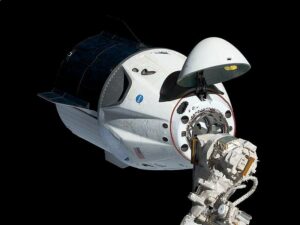A replay of our live coverage of the countdown and launch of a SpaceX Falcon 9 rocket carrying PSN’s SATRIA communications satellite from Space Launch Complex 40 at Cape Canaveral Space Force Station, Florida, can be found below. We are on Twitter.
A European-built communications satellite was the centerpiece of a nearly $550 million project to provide internet service to rural Indonesia during a Father’s Day launch from Cape Canaveral by a SpaceX Falcon 9 rocket.
At 6:21 p.m. EDT (22:21 UTC) on Sunday, the 4.6-metric-ton (10,100-pound) spacecraft known as SATRIA took off from pad 40 at Cape Canaveral Space Force Station on top of a Falcon 9 rocket built by SpaceX.
In the final seconds of the countdown, the Falcon 9 started its nine Merlin engines that were powered by kerosene. The hold-down clamps then opened, allowing the 229-foot-tall (70-meter) rocket to leave pad 40. The Falcon 9 thundered into the mostly sunny late afternoon sky a few moments later as it steered east from Cape Canaveral.
The rocket’s reusable first stage returned to Earth for a 420-mile (680-kilometer) downrange landing on a drone ship in the Atlantic Ocean. The SATRIA spacecraft entered an elliptical “super synchronous” transfer orbit tens of thousands of miles above Earth when the upper stage of the Falcon 9 fired its engine twice. According to a telemetry display on SpaceX’s live webcast of the mission, the Falcon 9 reached a top speed of 21,725 mph (34,963 kilometers per hour) with the final impulse from the upper stage engine.
Nearly 37 minutes after launch, the SATRIA spacecraft was launched by the upper stage. The first signals from the SATRIA spacecraft, which will use electric thrusters to maneuver into a circular geostationary orbit above the equator and unfold solar panels to recharge its batteries, were received by ground teams on standby.
The SATRIA satellite will take several months to enter its orbit at 146 degrees east longitude, where its velocity will match Earth’s rotation speed, giving the spacecraft a fixed coverage area over the Asia-Pacific region. The satellite will activate its communications payload, which consists of 116 Ka-band spot beams, by opening three antenna reflectors.
When it launches in November, the SATRIA satellite will provide 150 gigabits per second of communications throughout.
Satelit Nusantara Tiga, a subsidiary of the Indonesian satellite company PT Pasifik Satelit Nusantara, or PSN, will manage SATRIA, which stands for the Satellite of the Republic of Indonesia.
SATRIA will provide internet service to rural hospitals, schools, and government buildings over its 15-year lifespan, focusing on areas without terrestrial fiber connections. Indonesia, the fourth most populous nation in the world, has approximately 6,000 inhabited islands, making it more difficult to construct a national internet infrastructure.
Danny Januar Ismawan, infrastructure director for Indonesia’s Telecommunications and Information Accessibility Agency, stated, “There are still blank spots.” The telecom network of last resort is this satellite technology. Why employ a satellite? because terrestrial microwave or fiber optic technology makes it impossible.
Thales Alenia Space built SATRIA in Cannes, France. It was then transported by ship to Cape Canaveral last month to begin final launch preparations. The Spacebus Neo spacecraft design, Thales’ most recent satellite bus that debuted in 2020, serves as the basis for the satellite.
Individual users will not receive internet service directly from the new satellite. Instead, the Indonesian government-backed project will support schools, hospitals, and thousands of public WiFi access points where people can connect their computers and smartphones to the internet.
According to Usman Kansong, Indonesia’s director general of information and public communication, “For example, we place the WiFi there.” Because SATRIA 1 is a component of a digital transformation that will ultimately have an effect on people’s welfare, I believe the benefits are received indirectly by the community.
Including costs for the construction of the satellite, launch services, insurance, and ground infrastructure, the SATRIA project cost nearly $550 million, or about 8 trillion Indonesian rupiah. Two satellite control centers and telemetry stations were also included in Thales’ contract.
Adi Rahman Adiwoso, president and director of PSN, stated, “With a capacity of 150 Gbps, more than three times the national capacities that are currently still in use, we believe that SATRIA can be the solution to the digital gap that still exists in Indonesia.”
Indonesia will benefit from improved communications thanks to the second of a series of PSN satellites called SATRIA. The satellites Nusantara Lima, also known as Nusantara 5, and Nusantara Satu, also known as Nusantara 1, are scheduled to launch later this year on SpaceX Falcon 9 rockets to enhance the broadband capacity provided by SATRIA, also known as Nusantara 3.
Through an arrangement between SpaceX and the Indonesian telecom operator PT Telkom, PSN’s Nusantara broadband satellites in geostationary compete with the connectivity to Indonesian users provided by SpaceX’s Starlink internet network in low Earth orbit.
Palapa A1, Indonesia’s first communications satellite, launched in 1976 with the intention of providing broadcast services for television.
Engineers oversaw the countdown to Sunday’s SATRIA mission liftoff from SpaceX’s launch and landing control center, which is located just south of Cape Canaveral Space Force Station. In the final 35 minutes before liftoff, a million pounds of kerosene and liquid oxygen propellant were added to the Falcon 9 rocket.
With the assistance of an ignition fluid known as triethylaluminum/triethylborane, or TEA-TEB, the nine Merlin 1D main engines on the first stage booster flashed to life after teams verified that all technical and weather parameters were “green” for launch. Hydraulic clamps opened as the engines reached full speed, allowing the Falcon 9 to launch into space.
The Falcon 9 and SATRIA were launched into the upper atmosphere for more than two and a half minutes thanks to the 1.7 million pounds of thrust produced by the nine main engines. The booster stage then shut down and broke off from the upper stage of the Falcon 9 to begin a controlled descent toward the parked drone ship “A Shortfall of Gravitas” owned by SpaceX.
The booster, which was given the designation B1067, used cold gas nitrogen thrusters to control its orientation and extended titanium hypersonic grid fins. After that, it started three of its nine main engines for a nearly 30-second braking maneuver during re-entry. About eight and a half minutes into the mission, the rocket was slowed down for touchdown on the drone ship by performing a final landing burn using only the center engine.
After the nose cone’s two clamshell halves fell into the water, a SpaceX recovery ship was also poised in the Atlantic to retrieve the rocket’s payload fairing. About three and a half minutes into the flight, shortly after the upper stage engine of the Falcon 9 was ignited, the payload fairing was released from the rocket.
The upper stage engine of the Falcon 9 rocket was fired twice to propel the SATRIA spacecraft into an elliptical super synchronous transfer orbit. At T+plus 36 minutes, 47 seconds, it was confirmed that SATRIA was separated from the upper stage of the Falcon 9.
Disclaimer: The views, suggestions, and opinions expressed here are the sole responsibility of the experts. No Idea Scope Analytics journalist was involved in the writing and production of this article.




